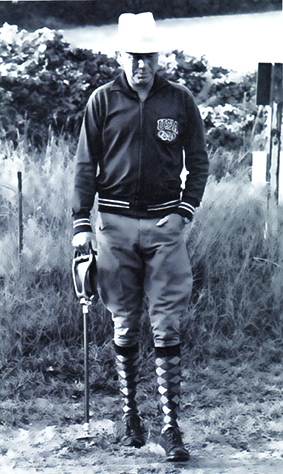
Here is one from our back pages. Back in 1986, Joan Gilchrist, Kiwi equestrian journalist extraordinaire, filed this story on the great man. He died in 2009…
Still, every word rings true today!
Jack Le Goff is the most successful coach of horse trials riders in the world. A bold statement, but one that will bring little challenge. Son of a French cavalry officer, he followed family tradition, first racing over fences, and then as a member of the French army’s famed Cadre Noir. The Three Day Event Champion of France in 1956 and 1964, Le Goff led the French Team to a bronze medal at the 1960 Rome Olympics and was a member of the Team at Tokyo in 1964.
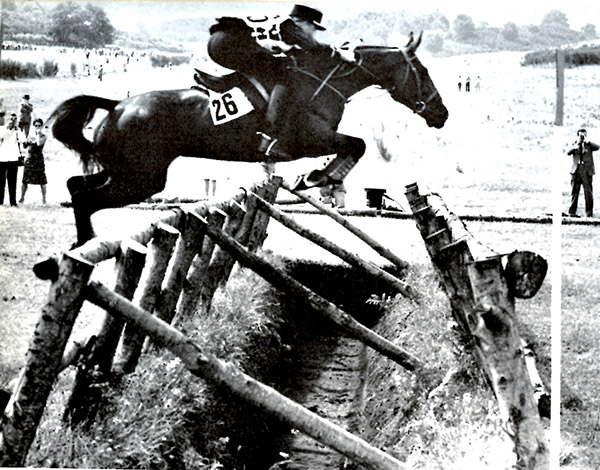
Jack at the Rome Games 1960 – riding Image
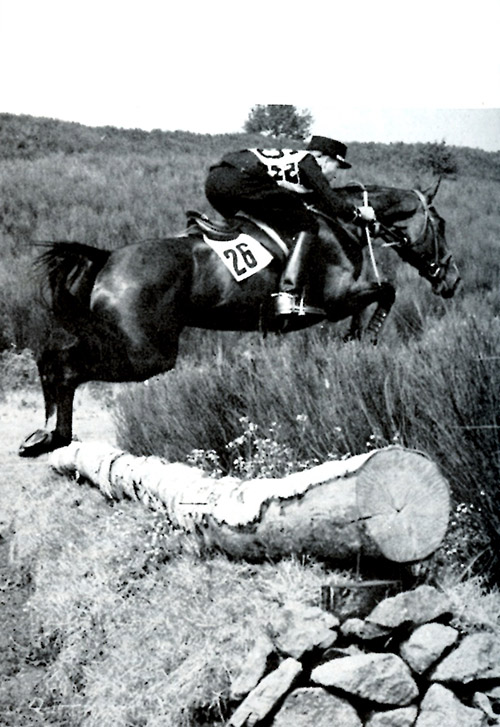
Jack Le Goff then became coach of the French team, producing the 1968 Mexico Olympics individual gold medallist, Jean-Jacques Guyon on Pitou. Under his leadership, the French won team gold and individual gold and bronze at the1967 Junior European Championships in Britain, repeating team gold in 1968, together with individual silver and bronze.
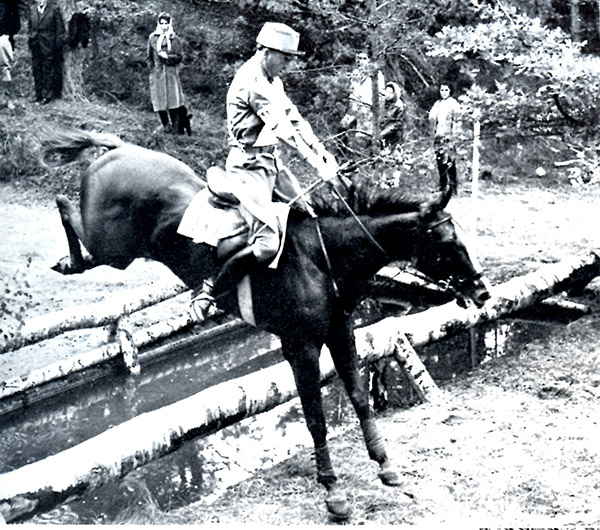
Le Goff wins the French National championship on Laurier
In 1970 he was appointed coach to the United States Equestrian Team’s three-day squad, retiring at the end of 1984 after 15 years in which the Americans consistently won World, Olympic and Pan-American honours.
The USET record during that time is outstanding! Olympics – two team Gold, one team Silver, one individual Gold, three individual Silver, one individual Bronze. World Championships – one team Gold, two team Bronze, two individual Gold, one individual Silver and one individual Bronze. Pan-American Games – one team Gold, one each individual Gold and Silver.
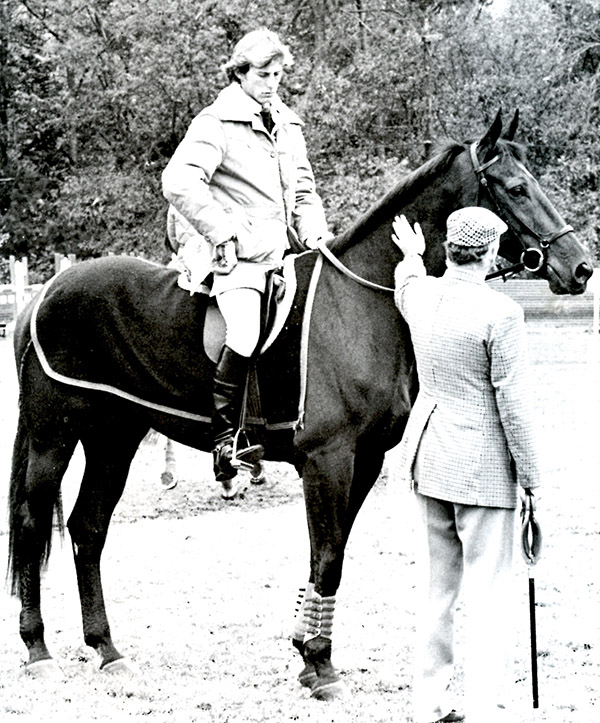
Jack with his star pupil, Tad Coffin, individual and team gold at the Montreal Games
more follows…
In 1983, Le Goff was awarded the Wofford Trophy, presented to the non-riding member of the USCTA, who has contributed most to the sport and he was nominated for and awarded the Mercedes-Benz Award as the 1983 American Horse Shows Association Horseman of the Year for the individual who has made an outstanding contribution to the equestrian sport.
The USET were too aware of his talents to let Le Goff go altogether, and on his retirement at the end of 1984, he was appointed director of the rider and horse development programme.
He was a welcome visitor to New Zealand where I had the opportunity to interview him. Jack Le Goff is every bit as charming as one would expect a former French chevalier to be; he has a puckish and penetrating sense of humour; admits to a love of good food and wine and much admiration for pretty ladies. He is a keen fisherman – and during his time in New Zealand accounted for eight splendid Taupo trout… to his great delight.
He is also an exceptionally gifted horseman and teacher. One ‘eventing husband’ said: “I was going to watch him coaching the dressage for 10 minutes before I went to work, but I was riveted and I finished up staying ’til lunch time. He is brilliant.”
He spent an evening with a group of riders, informally, and, without benefit of horse, arena or jumps, expounded and demonstrated his basic philosophies of riding technique and quite apart from passing on a fund of information, had his audience roaring with laughter at his droll expressions and incisive wit.
Jack Le Goff was the first professional coach in France, as Eventing made the transition from an army to a civilian sport. “There was a lot of politics involved and I thought there were a lot of better things to do than playing politics.”
After the 1968 Mexico Olympics, he went into private business and within a year several countries had approached him to coach their eventers. He chose to go to the United States. At that time he didn’t speak English – he now, of course, speaks it fluently, still with a French inflection and an American overlay.
His wife, Madeleine, studied in America and was fluent in English.
When Le Goff arrived in the States, he went to the USET’s Gladstone headquarters, home of all disciplines. Then, after four years, the eventers moved to their Hamilton, Mass., property where they are now based.
“The Americans had been in the money, though they hadn’t won for a while. When I got there, there were really only three riders still active who had international experience – Mike Plumb, Kevin Freeman and Jimmy Wofford. Nobody else was at that level and there were very few competitions.”
“I remember going to my first Trials in 1970. It was an Intermediate event, and there were four horses in it and they were not very good. I thought ‘Oh boy, I’ve got my work cut out here!”
“I was very very lucky because I came at a time when it was ready to go and I took my job as coach at the same time as Neil Ayer was President of the U.S. Combined Training Association.”
The two combinations work hand in hand, but have different purposes… the USCTA responsible for organizing competitions and the USET responsible for training and putting the teams together.
“Neil and I got along very well together – we never worried who was wearing which hat. He put on the competitions and I put on the riders. I would say it was the most fun part of my life, those early years when we were really building up. It was a lot of fun seeing it grow from maybe twelve events worth going to, to today where there must be over 200! The level of horses and the riders obviously improved – and I believe when we won World Championships in 1974, that really set things going. It generated interest among young people, and publicity. That’s what happened to us – it really was a key to the forward leap of the sport. Then we got lucky again in the Olympics in ’76 and it went on from there.”
Statistics show that where Le Goff may have started with three riders, in the fifteen years since, a great many riders have made the team at the top level. That means now there is an important group of riders with experience at international level and a lot of good events to allow them to prepare themselves and their horses.
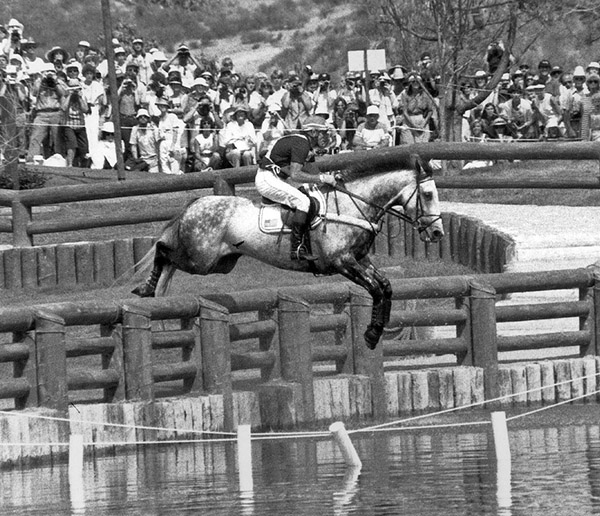
Mike Plumb – one of the quartet
“I reversed what had been going on – for several years there had been basically only four riders, pretty good riders, and some made horses bought for them. I did not believe that was a sound situation because that policy means the young rider has very little chance to get on the team – and if he doesn’t have the chance to make the team, why would he try?”
“You can’t develop the sport that way. I realised that right away and decided that I was going to try to make riders. I organized a lot of training sessions and I ran screening trials and selected four every time and then put them through the mill. I have to say it was a pretty grinding mill because I didn’t have much time. Then the next Olympic cycle, I would do the same again… and pretty soon I found myself with a dozen riders. I believed in having more riders and educating them.”
What do you look for in a rider?
“The qualities are very similar to those you look for in horses!”
“First, conformation, like you pick a horse. You look at how the horse is built. So, you look at how the rider is built. But we all know there are plenty exceptions and very good ones. Basically, a rider should be not too big, not too small.”
“The factors are conformation – and maybe it will offend people to make the comparison with an animal, but I don’t mind – and temperament, as with a horse. I look for somebody who has the determination, but also is pretty good under pressure and has the guts. A good event rider, like a horse, should be bold. If they are not bold, they are not going to win.”
“A good disposition, temperament, in that they are determined but cool, calm under pressure.”
“I’ve had many riders who are terrific at home, but fall apart under competition, because they can’t control their nerves; and others, who are not good at home, but wake up in competition.”
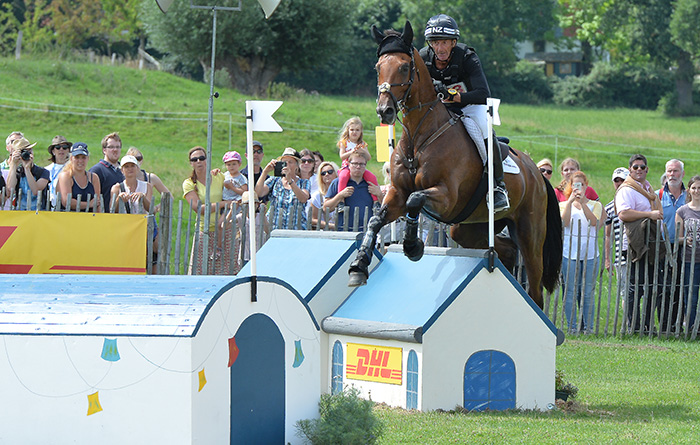
Mark Todd – he rides with feelings
“So you have conformation and temperament in the rider. Obviously they have to have good reflexes, be a bit athletic, be sharp. When you have those qualities from there on you can teach them – if they are teachable – and you can train them.”
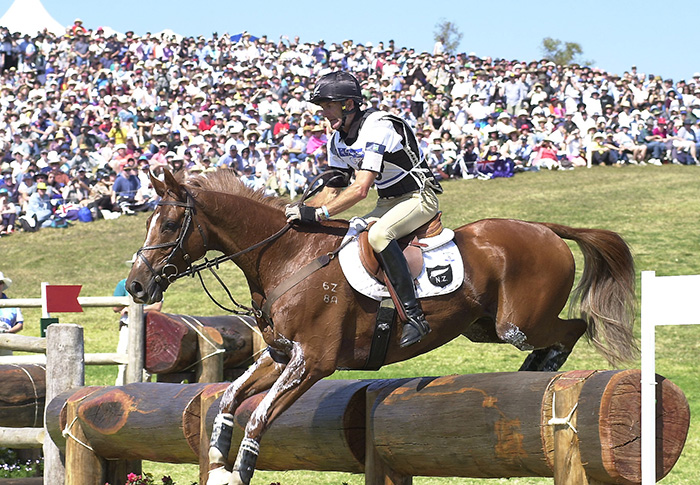
“Obviously some have more feelings and I think that is the next thing I like in a rider. Feelings are very important to me – if I was asked what I liked best about Mark Todd, I would say ‘feelings’. He is very sympathetic with horses because he ‘feels’ the horse and gets along with all types of horses. And there you go – he is very tall but he can ride a small horse because somehow he finds his place on the horse and is very sympathetic, so he has the right temperament, He is determined, knows what he wants, is very calm – I like him a lot.”
“Actually, if you compare the rider with the horse you are going to have a lot of similarities. Is he the type that can do it? What kind of temperament? Is he athletic, a good jumper and mover? Is he bold? You have thousands of horses that are excellent jumpers but are chicken and they’ll never make it. I think it’s the same with riders. They may have a lot of talent, but are a bit chicken, they’ll never make it. But if they are bold, we can polish them. If they are good listeners and good students, you can educate that boldness and they will use and refine it. Make them realise that it is not a poker game, a win or lose type cross country ride. They will be bold but will use it smartly to make it work, won’t take unnecessary risks.”
“There is a difference to me between being bold and being cuckoo!”
In teaching riders, he spends ‘an awful lot of time’ on the basics, on ‘teaching the rider how to ride properly.’ Le Goff also emphasises teaching a rider to ‘think, to be accurate, organized, methodical.”
That goes hand in hand with his conviction that ‘riding is simple. It is logical.’ “My primary philosophy is that I want to teach the riders how to ride. A lot of people learn how to compete before they learn how to ride. And if they do that, they will get stuck at some point. Just like sending someone to university who hasn’t been at high school. So, I want them to learn how to ride before they really learn how to compete. I have to take the chance they will be good competitors, which is where the temperament comes in.”
“I work on the basis of two very important things. Flat work or dressage and basic jumping – and basic jumping to me is the same whether you talk showjumping or cross country. Mistakes are being made today by riders saying – ‘I’m an eventer’ – so they don’t go to dressage competitions or showjumping. They want just to go straight eventing. I don’t think you can do that very successfully. Oh, you can do it, but if you are to succeed, you are far better off to work on the basics of dressage and jumping first, and have a good foundation – then the rest becomes quite easy. And the basics of dressage and jumping are very closely related.”
”You can only get away with so much so far – look at the best showjumping riders today, they don’t call it dressage, but they are practising it.”
“I think that hunter jumping is good because it makes the rider, since they are judged on position and use of the aids. Some don’t understand it. They think it’s not exciting. But it is definitely what has brought the US up to where it is in the jumping world. I believe that what the US did in the Olympics at Los Angeles was due to the everyday concern of work with the basics, and that applies both to the show jumpers and the three day. It has to be realized that you can’t win today unless you are really technically very good, you really have to know what you are doing. You may win once by luck, but it’s not going to be consistent and I think that comes with the work, the concentration, the every day application of flatwork, and sometimes it takes a lot of determination.”
“Take eventing today. You can only go so fast, you can only go so clear in showjumping, if you’re clear, you’re clear, you don’t get any more points. So where can you save points? In Dressage.”
“When those guys called Australians came to Europe in the late fifties, with their big hats, they SMOKED around Badminton and Harewood and a few other events before going to Rome. Then everybody said, ‘Ah, they just got lucky’. Because in those days if you rode a decent dressage, went clear cross country and showjumping, you were in the money, even if you didn’t go too fast. Those guys SMOKED those courses and they got lucky once and they got lucky twice and they got lucky in the Olympics in Rome too.”
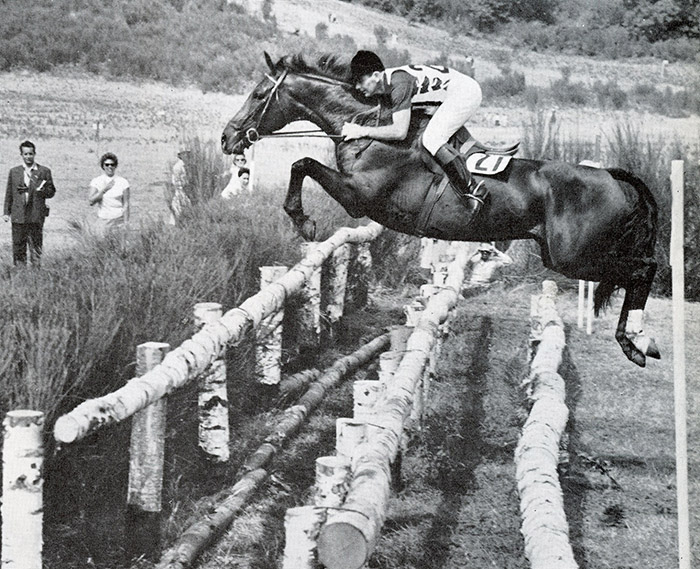
Neale Lavis smokes his way to individual silver and team gold at Rome on Mirrabooka
“And from there on, there was no turn around. Everyone decided that if you wanted to be tops, you had to go fast cross country. Fine. At that time, dressage was regarded as a necessary evil to be done before the cross country and the showjumping, well you tried to get away with it. Since everyone was starting to go fast, and people could get away with showjumping, then they started to realise that not only did you have to go clean and fast across country but you had to have decent dressage, otherwise you weren’t going to be there! A lot of people are going to go clear and fast; they’re going to go clear showjumping,so what is left?”
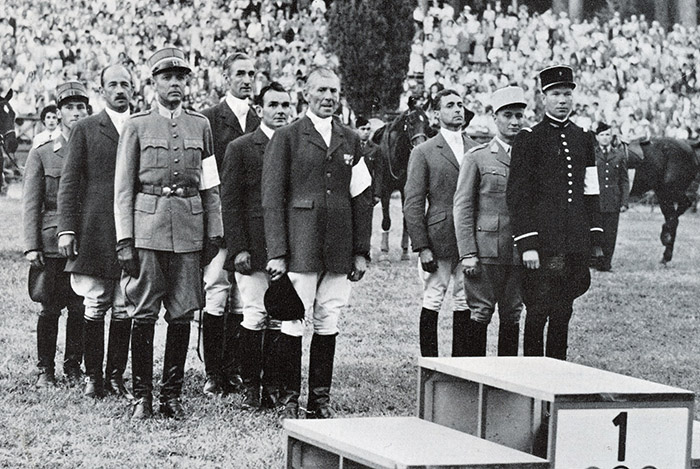
Team medals in Rome – the Aussies, Laurie Morgan, Neale Lavis and Bill Roycroft collect gold – that’s Jack at the front of the bronze winning French team.
Jack LeGoff is a disciplinarian – he believes in the discipline of self discipline. And he is a notoriously hard taskmaster.
“I am a hard worker. I expect people to work as hard as I do. I am probably demanding in the quality of things, yes. I don’t settle for second best. I am probably not too much of a commercial teacher, I guess, in that I don’t worry too much about what is good. Let’s work on what has to be improved. I like to get the job done.”
Dressage judging at all levels in horse trials is a contentious subject.
“I don’t worry about it. First of all, my philosophy is that by the time you sign your entry form for a big event, you accept the judgment of the thing, and I have never bitched about that. I think very often it is a bad excuse for people who cannot produce a good dressage test, to blame it on the judges and that’s a fact. I believe if you do a good, or fairly good dressage test, you might have some difference of opinion but you will still be near the top. Don’t forget that you have to put everything into perspective – dressage in eventing has a factor of 3 in 16. That means it is worth three-sixteenths of the marks… you have three judges, so you have to divide again by three and if you have a bad guy then his influence is very small. I really cannot buy the excuse of being badly treated in dressage. It’s happened to me too – I thought maybe one was tougher on a horse than he might have been – but it goes the other way, and I’ll think, he was kinder than I would have been to that other horse!”
Jack Le Goff feels that cross country courses are becoming more technical. He believes that a good course today is a course where the majority of competitors get around, ‘if they belong there’. A course where there are some options so that a good horse and rider will take a quick option and make the time and a less experienced pair will still get around, but collect the time penalties for taking the easy options.
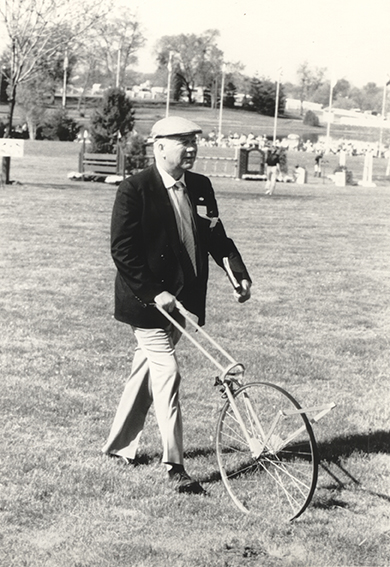
“It’s a matter of balance, it can go too much one way, too much the other. The course at the 1982 World Championships at Luhmühlen was a very interesting course, but the long way was not costly enough, so everyone went the easy way because they didn’t waste enough time and there were some fences that were never jumped.”
“I believe the L.A. Olympic course at Fairbanks provided a fairly good example of a fair course. I wouldn’t consider it one of the toughest ever, the conditions were OK but they could have been terrible.”
“It was hard to predict, but it would have been a disaster to have another Lexington, which was too big, too demanding. There were some beautiful fences at Lexington (World Championships in 1968), each on its own was wonderful, but the accumulation of all the great fences and the climatic conditions made it too tough.”
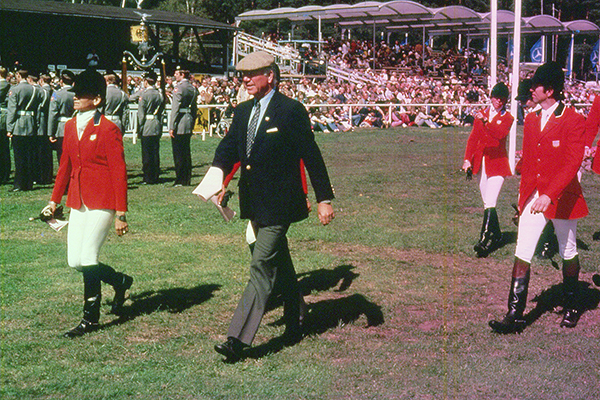
Walking the course with the American team at Gawler in 1986
“At Los Angeles a lot of horses got around, the best teams came on top. I thought the terrain was going to be worse – it rode much better than I thought that roller coaster would. It’s not necessary to kill horses.”
A cross country course designer himself, he likes to challenge and test the riders rather than the horses. So, Jack Le Goff prefers a more technical course.
“I hate to see horses falling – I’d rather have stops that are due to riding. I put the pressure on the riders – horses are my friends and I respect them and I don’t use them. I like to cooperate with them, I like them to cooperate with me. I don’t like to give them a hard time, so I’d rather put the pressure on the rider and you can do that very easily.”
He talks about the Olympic Games, a little wistfully as he recalls years past… “They have grown from being a real sporting affair to being a huge international business, very influential and can be used politically. It’s kind of grown into a monster. But that’s that – and lots of alternatives are talked about, like finding one site, or breaking it down into sports in different places.”
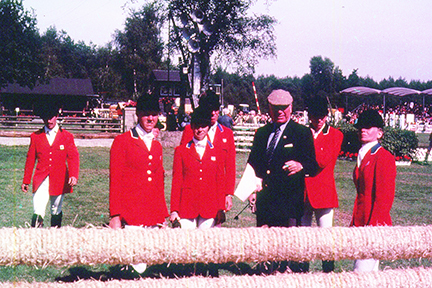
“I would have to say that I have been involved in eight Olympics straight. My first was at Stockholm in 1956, when because of Australia, the equestrian sports were held in Sweden, with all three disciplines. Maybe because it was my first one, that is the one I probably enjoyed the most, where I got the real feeling of the community of the equestrian sport being together. I liked it a lot, thought it was great.”
“Now you are participating in the Olympics but there is so much exploitation in different ways. There are other factors interfering with the real sport. In Montreal – oh boy, machine guns all over the place. In a way Los Angeles was quite good- sure there was a lot of security, but it wasn’t too obvious.”
“But you do feel, in the back of your mind, in your heart, that there is a threat somewhere. That the event is being exploited for purposes which are far from sport and it gives me a very uncomfortable feeling, but you can’t avoid it.”
“I personally favour separating the sports in different venues – that’s why I like so much the idea of the World Championships altogether in Stockholm in 1990. It’s less likely to be exploited; it’s a whole community of sport getting together, doing the same thing.”
His on-going relationship with the USET is a continuation of that body’s policy of looking to the future with the development of young riders. Le Goff, as well as being Director of the Hamilton Centre, is director of the rider and horse development programme, dealing with riders who have not ridden for the team. As soon as they have been on the team, they leave his jurisdiction.
Jack Le Goff is adamant that his responsibilities will not cross back into the team itself. “I would have hated having someone interfere with me, and I owe it to whoever is responsible now not to get in the way. I get calls asking my opinion… and I just won’t get involved. I’ve got it cut and dried now.”
Jack Le Goff organizes training sessions throughout the country for young riders. He may have up to 150 applications for thirty spots – “sorting them out is very tough. To be honest, fair and efficient as possible.”
He has just put together a young rider’s scholarship programme, selecting four from each training session he takes. These riders will spend three months at the team centre for intensive training. “We hope in the long run some will take the place of the current top internationals when they retire.”
He is the manager of a group which has syndicated the French jumping stallion, Galoubet. This year, he organized for the first time, a jumping ‘Talent Derby’ at the Hamilton complex, following which the top six placegetters were invited to a ‘dressage for jumping’ clinic conducted by Le Goff. He still attends numerous events and is ‘always available’ to help out.
“And I have plenty of hobbies… I love to work hard, and I play hard too. I love the outdoors, hunting (shooting) and fishing. When I am home, I like to garden. I love good wine, good food. I admire good looking ladies.” He is happy that his retirement as coach means he is at home more and that the periods away from home are shorter and less frequent, so that he can spend more time with his family.
“I have been very, very lucky to have several riders who had talent, you put that raw talent through the mill and hopefully get something good.”
Those who have seen the Americans compete and those who have ridden against their top eventers in recent years would doubtless regard that reflection as a masterpiece of understatement.
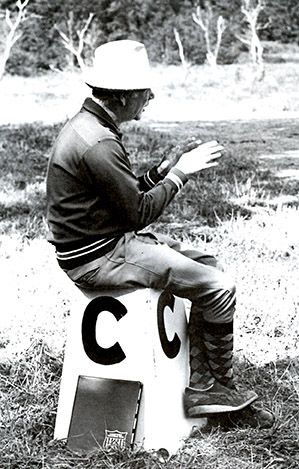
THE EVENTING GOSPEL – according to Le Goff
Le Goff has an extraordinarily mobile and expressive face and body and he uses both with wit in his teaching and clearly is a great believer in ‘body language’. Come with us to a very informal session in a private home where he talked to a small group of riders. Le Goff used what little floor space there was to demonstrate to great effect what he was talking about and, as his philosophy made it all seem so logical, simple and straightforward. In turns, he was a young, unbalanced horse; the rider on the end of the reins; the lady with the eighteen-and-a-half inch rump trying to ride in a sixteen-and-a-half inch saddle; the tense rider with ‘dead fish eyes’ instructed to look up; the rider doing sitting trot to shoulder in, to shoulder out, to half pass, into canter, then one time changes… all without moving his feet which, as he commented, ‘tells us something!’ It sure did!
He used a camera strap to let riders ‘feel’ what the horse ‘feels ‘ at the end of the rein; he used his hand on one rider’s rib cage, as the horse’s side, to demonstrate the difference between a leg that nags and one that merely ‘feels ‘. He entertained, enlightened and informed over a two hour period that passed far too quickly, and left your correspondent wishing she was an event rider just to be able to go on one of his courses!
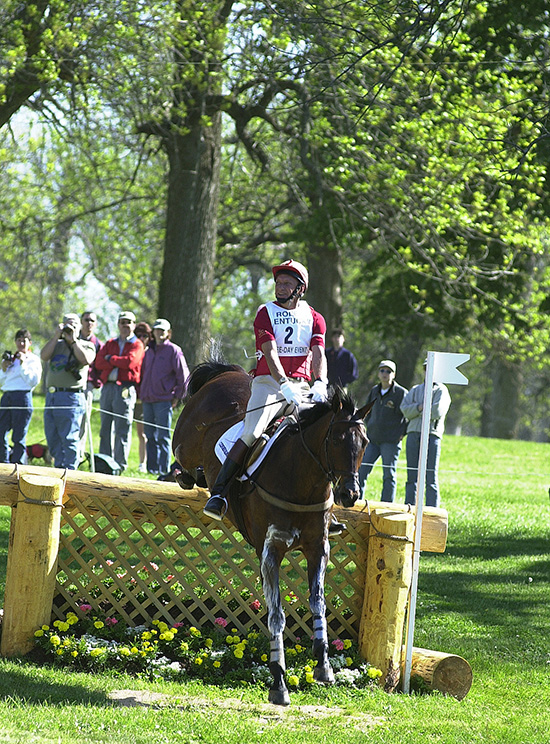
Bruce Davidson and Eagle Lion, World Champion, here competing at Kentucky, Davidson was probably Le Goff’s most successful student.
The words – Jack Le Goff:
People sometimes make a big mystery of what we call dressage, which is just riding a horse on the flat. It sounds much more complicated than it has to be. I believe riding is simple. It is logical. As riders, everything we do should be logical. There should be a reason for everything we do and as long as we understand it we can see progression in everything we do.
There is an ideal place to be sitting on a horse. I spend a lot of time getting riders to be in the proper place because it gives the best chance to communicate with the horse. It is all a matter of communication between horse and rider. You must be able to convey the message of what you want to do.
From the side, the rider should be pretty much above his feet, you ride the same way you stand. The weight should go right straight through down to your heels, the only difference from standing is that you have one leg on each side of the horse.
Everybody talks about sideways or lengthways balance… not many talk about lateral, or back and forward balance. Sit forward in the saddle, carry your lower back.
The most important point of contact is the part of your leg right below the knee … the upper calf. That’s the part you want to have ‘feeling’ the side of the horse. Sit ‘down’ in the saddle; sit ‘up’ with the body.
Feet: Some people ride at 25 to 5, some at 10 to 2 – do it the way you walk, unless you walk at 25 to 5 or 10 to 2! Be as natural as possible. Your conformation can make a difference. Ladies normally have a little rounder seat.
Let the arms hang down, just flex them in front of you. You want concentration without contraction. Hold the reins with the thumbs, so your fingers can be soft, elastic. You can press a bit with your thumb. Don’t lift the thumb and try to hold with your fingers. Feel it – you get contraction and that is what the horse feels in his mouth. We do everything else – drive, write, eat – with our hands in front of us. Why suddenly bring the hands into the body to ride? We always hear ‘heels down’ – why, what does that mean? It lengthens the leg and muscles. Keep your feet on the ground, raise your toes – feel the calf muscles getting longer. Raise your heels – those muscles go round and hard.
Lateral balance: Regardless of the turn or the curve, the rider has to sit in the centre of the horse. Imagine those women in Africa who carry the great weights on their heads. Put the weight in the centre of the head – your horse feels that weight on his back and if you go off-centre, his normal reaction is to try and put himself under you. Then you say – ‘he leans in on the corner’, he doesn’t, you do! Lateral balance is important in that you must sit in the centre, the weight of the rider should be smack in the centre of the horse. Sit forward in the saddle – carry your lower back and your upper body- carry your arms lightly – then you have a very natural seat.
Use of the Aids. The horse must accept the feel of the rider’s leg against his side, and the part of the leg we are talking about is the upper calf. Feel that it is resting on the side of the horse. I’m lazy, I don’t want to squeeze all the time. So, I look for other ways of getting the horse in front of the leg. Get the horse accepting the leg resting on him. Press. If that doesn’t work – tap; then bang; then kick. But don’t squeeze, all you get is tension.
There is too much artificial contraction created by the rider. If the horse is a little heavy, especially a young horse which is not yet balanced, people say ‘put the leg on and give him a pull’. You do that – you are putting your foot on the accelerator and pulling on the brake and saying ‘Don’t go’! And you wonder why he is confused. Use the body – not just the hand – to increase the pressure, but don’t then drop him.
The progression is as with the leg – degree of effort. Finger, wrist, arm, weight and the wrist must be straight to give flexibility. There is a place that is ‘home’ for your hands in front of the saddle.
If a horse rushes into his fences, and you pull back and pull back, you never solve your problem. He will go right through your hands because he feels uncomfortable. So, you ask ‘How do I hold the son of a gun?’ And that is it – you hold. Don’t pull. If the horse is not balanced, make a little half halt – but the reins should be coordinated. If you don’t approach a problem logically, you end up putting the blame on the horse.
You tell me what your horse does – but you don’t tell me what you do! Ask yourself – ‘Am I really doing the right thing?’ Most of the time, if the horse doesn’t respond, it is because the question asked is not clear enough; he doesn’t understand.
While we’re on the subject let’s talk about gadgets. I don’t believe in gadgets. I have only snaffles. Oh, there might be a double bridle somewhere. Don’t go to the ironmonger – don’t use gadgets. Go back to the problem. A lot of gadgets you see being used in eventing have come from the showjumping ring. Like fancy bits. They may work for showjumping – they won’t work for eventing. And there is a very simple reason. The showjumper is in the ring for only one and a half minutes. Most of that time, the rider is on the bottom, balance wise and the turns keep him that way. He is taking much less hold and only for a short period of time. Imagine yourself in a three day event. You think ‘this gadget is the answer to my problems’. That gadget, whatever it is, is putting on a lot of pressure somewhere … that’s OK for a minute and a half, but after a while wherever the pressure is, when there is too much pain, it goes numb. Not only do you cut the lips, but the bars or whatever go numb. That is why a gadget may work for a showjumper but not for you. Stay away from gadgets.
OK, you may need a gag, I’m not talking about that, but use the gag with a double rein, so you can ride on the ordinary snaffle and use the gag only when needed. You have to be a hell of an artist to have only one rein on a gag. You must use ‘body talk’, a good position is your best chance. You have to know how to use your aids, but all that is no good if you don’t use your body. Feel with yourself, be with your horse.
You’ll find is someone is a good dancer, he will be a good rider because he ‘feels’, he has rhythm.
On Jumping
I believe jumping is very related to flat work. There is not one way to ride on the flat and another to ride over jumps. I have been asked questions to which I did not have a logical answer about jumping so I went fishing for a couple of days and thought about it.
There are three things intimately related in jumping: your body angle; your contact; and the length of your stirrup. They are very important to jumping and very much related. There are two extremes: the straightest you will ever be in the saddle, the longest you will ever have your stirrups, the lightest your horse will ever be, is in piaffe, on the spot, where there is no forward movement.
At the other end of the scale, the shortest your stirrups will ever be, the most forward the body will ever be and the most ‘enthusiasm’ you will ever have at the end of the reins is when you are flat racing. Those are the extremes. In between these two, a lot of things happen.
If you are rising to the trot, your horse is in forward motion and gaining some ground. While you are ‘up’, he is going forward, so when you land in the saddle, if you trot straight up and down, the horse has moved forward and you are a little bit late. When your horse jumps a fence, he pushes and jumps forward in the air. The rider has to gain and move up on the neck, on the forehand, to compensate. If you are going to jump a small fence, you don’t need to compensate as much as if you are going to jump a seven and a half foot wall.
Think of the horse climbing up that wall – the rider is almost parallel to the horse. He must keep compensating for the horse climbing. The seat is ahead of the withers even. It is a matter of gravity, balance. As a rule of thumb, try to keep your body angle pretty consistent with the ground. If it is a small fence, you don’t have too much lean, or such short stirrups. The bigger the fence, the shorter the stirrups. You should not have one length of stirrup to jump small fences, go cross country and showjump. You have to be willing to adjust your stirrups according to what you are jumping.
The job of the rider and the reins is to keep the horse in balance that is correct for what you are doing. The slower you go, the tighter the turn, the more you have to sit in the saddle. Over the fence, if the horse is not hanging on your hands, you can release all you want, because you are not changing your balance. The tension on the reins is in proportion to the energy at the end of the reins.
If I am riding a green horse on an up and down course, I have a longer stirrup than when I am riding in an Olympics or World Championship on an experienced horse that is fit and ready to go over an open course. I am asked: ‘What do you need to do to jump a fence properly?’ If you think about it, and break it down, you need five precise conditions and they all mean something. Direction: Speed: Balance: Impulsion: Timing
Direction: includes where you are coming to turn to approach that fence; the trajectory of the horse over that fence; landing and where you go after the fence. In other words, the line you take.
You normally walk the line the way you hope to go, the way you hope is best. I never train a horse to jump corners – I just do it. If you can, get the horse to be accurate over a jump.
For instance, take an oxer with striped red and white poles. I will put a glove (marker) on a red stripe on the front pole and also on a white stripe on the back pole, and I say ‘You jump on that angle’. If you can be that precise, you won’t have trouble with corners. Train them to be accurate and to follow the direction you maintain with both your reins and your legs.
You see a lot of horses drifting over their fences. There is no such thing as the ideal horse – they all need help somewhere. That’s why the rider is there – to help the horse. You must use your aids to keep the horse from drifting. You must keep operating in the air. Don’t be a passenger, be a pilot. Don’t put your safety belt on as you take off and say – ‘See you on the other side!’
And nothing of that is possible unless you have eye control, you must control your eyes and your eyes control where you go. Keep your eyes on the road – you can’t drive a Formula One racing car at high speed with your eyes shut! Speed. You are not going to jump a vertical at the top of a slide at the same speed as you would jump a wide open ditch in the middle of a field – otherwise you would airborne! You have to adjust your speed to the fence you are jumping.
Impulsion:
Everybody talks about it, what is it? To me impulsion is the horse alive, who wants to go forward. It is the tap you open and you get the full pressure of water … ‘Swoosh’. lt gives you something to work with. When you ask the horse, he goes forward. You can let go more or less according to the pressure you want to use. Impulsion is the desire to move forward, being positive.
The horse and rider must be positive. Go to the fence, don’t let the fence come to you. It is a mental thing. You need the full force of the tap – not ‘drip, drip, drip’. Impulsion is also how fast the horse responds when you ask him to go forward. It’s the difference between trying to start a car on a cold morning in degrees of frost, and getting the full throated roar first turn.
Timing:
If your horse cannot jump comfortably on the flat, you don’t want to ride him across country, well you might, but I certainly don’t! Your horses are all capable of jumping more than they are asked to do at events and they should be. He has to jump a five foot, nice, well-made fence, if he cannot, he flies too low as far as I am concerned. I am not going to ride a low flier!
It is one thing to jump a four foot fence fresh, it is quite another to jump the same fence at the end of a cross country and you come to a big fence at the end. If you don’t have a horse with enough scope, you are in deep trouble. If the direction is correct, the speed adjusted to the fence, the horse is balanced and you have enough impulsion, even if your timing is not that good, provided his scope is enough, he will jump it.
Timing is far more important for showjumping, for that, it would be much higher up the scale of the five factors. But don’t showjump your cross country fences. For one thing by the time you get to the finishing line, everybody will be showered and changed! Secondly, if you start to check, check, check until you find the stride, you are going to waste a lot of time. Most times, you will find that you don’t have to worry too much about timing. You worry about getting that son-of-a-gun over to the other side of the fence! The first thing in cross country is to get to the other side of the fence! You worry about how later.
You can polish it later, right now you have to get the horse on your leg AND GO!
Want to breed a top jumping prospect? See the selection of top European bloodlines available from International Horse Breeders: www.ihb.com.au
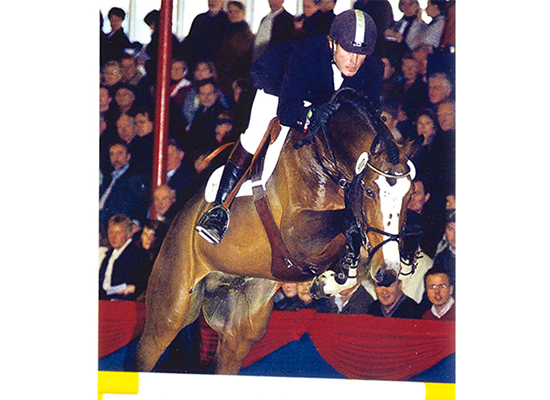
Balou du Rouet



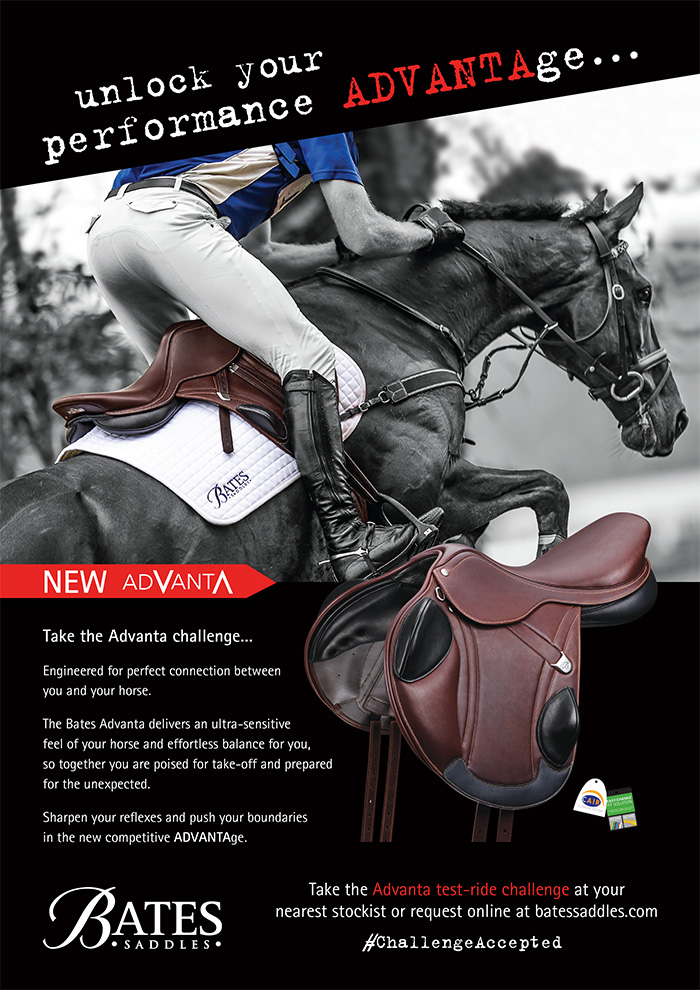


indeed wise words